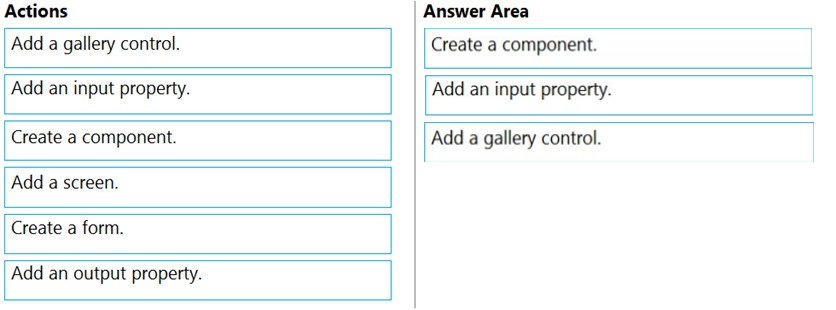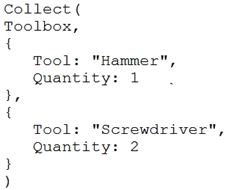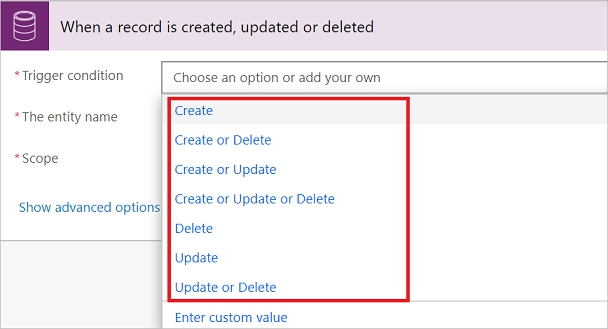DRAG DROP -
You create an app with multiple screens.
Test users report that the size and type of gallery displayed on each screen are different. You must improve the consistency for the app screens.
You need to create a reusable gallery that displays information based on the current record.
Which three actions should you perform in sequence? To answer, move the appropriate actions from the list of actions to the answer area and arrange them in the correct order.
NOTE: More than one order of answer choices is correct. You will receive credit for any of the correct orders you select.
Select and Place:
Answer:

Reference:
https://docs.microsoft.com/en-us/powerapps/maker/canvas-apps/add-gallery https://docs.microsoft.com/en-us/powerapps/maker/canvas-apps/create-component
You use a Microsoft SharePoint list to record information about customers.
You must perform a series of actions only when a new item is added to a SharePoint list.
You need to configure a Power Automate flow.
Which trigger should you use?
Answer:
A
Trigger - When an item is created
Triggers when an item is created.
MS Flow will trigger when an item is created in the list. It will return all list item properties which can be used in the Flow.
Incorrect Answers:
D: Trigger - For a selected item
This trigger allows you to start a flow for a selected item in a SharePoint list or library. You can use the columns of the list or library as output parameters. For a file, you can use the "identifier" column to get file content.
This is basically one which will trigger a flow when an item is selected and you want the user to trigger workflow manually.
Reference:
https://www.c-sharpcorner.com/article/sharepoint-based-triggers-in-ms-flow-part-2/
A company has a Common Data Service custom entity that stores customer account data.
You need to create a relationship between the custom entity and the Account entity.
Which two tools can you use? Each correct answer presents a complete solution.
NOTE: Each correct selection is worth one point.
Answer:
BC
There are two designers you can use to create and edit 1:N (one-to-many) or N:1 (many-to-one) relationships:
✑ You can create and edit 1:N (one-to-many) or N:1 (many-to-one) entity relationships in Power Apps portal
✑ You can create and edit create and edit 1:N (one-to-many) or N:1 (many-to-one) entity relationships using solution explorer
Reference:
https://docs.microsoft.com/en-us/powerapps/maker/common-data-service/create-edit-1n-relationships
You create a canvas app for technicians at a computer store. You assign technicians cases to work on. The technicians update cases at the end of customer site visit.
The manager wants the technicians to sell warranties to the customers. If a customer agrees to purchase a warranty, technicians must use the canvas app to immediately alert the sales team, and then the technician records details about the warranty into the app.
You need to create a flow to alert the sales team.
Which type of trigger should you use?
Answer:
A
Create a button flow to run routine tasks by simply tapping a button. Customize your flow by allowing the user to provide specific details that will be used when the flow runs.
Note: There are many repetitive tasks that we all wish we could run with just a tap of a button. For example, you may need to quickly email your team to remind them to join the daily team sync, or you may want to start a new Visual Studio Codespaces build of your code base after you've been notified that there are no more checkins planned for the day. Button flows allow you to accomplish these and many other tasks simply by tapping a button on your mobile device.
Reference:
https://docs.microsoft.com/en-us/power-automate/button-flow-with-user-input-tokens
HOTSPOT -
A coworker creates a canvas app.
The canvas app contains the following formula. The formula is attached to the OnVisible property of the first screen that users see:
You are updating the canvas app.
For each of the following statements, select Yes if the statement is true. Otherwise, select No.
NOTE: Each correct selection is worth one point.
Hot Area:
Answer:

Box 1: No -
Records are added, not updated.
Box 2: Yes -
The Collect function adds records to a data source.
Syntax: Collect( DataSource, Item, ... )
DataSource ג€" Required. The data source that you want to add data to. If it doesn't already exist, a new collection is created.
Item(s) - Required. One or more records or tables to add to the data source.
Box 3: No -
No records are cleared.
Reference:
https://docs.microsoft.com/en-us/powerapps/maker/canvas-apps/functions/function-clear-collect-clearcollect
You are an app maker.
You want to create apps and track customizations as part of the default solution.
You need to determine the impact of performing the work in the default solution.
What should you conclude?
Answer:
C
Default Solution. This is a special solution that contains all components in the system. The default solution is useful for discovering all the components and configurations in your system.
Why you shouldn't use the default solutions to manage customizations
There are a few reasons why you shouldn't create apps and make customizations in either of the default solutions:
✑ The default solution can't be exported; therefore, you can't distribute the default solution to another environment.
The default solution contains all components and customizations from all solutions in the environment.
By default, all enabled users can create apps and customize components in the Common Data Services Default Solution.
It's difficult to locate or identify the customizations you've made in the environment by using either default solution.
When you use either default solution to create components, you'll also use the default publisher assigned to the solution. This often results in the wrong publisher prefix being applied to some components.
Reference:
https://docs.microsoft.com/en-us/power-platform/alm/use-solutions-for-your-customizations
You are creating an app for an organization's human resources (HR) department. You create an Employee entity in an unmanaged Microsoft Dataverse solution.
Another user creates the following Power Automate flows separately from the solution:
You need to incorporate the flows that can be added to the solution.
Which two flows can you include? Each correct selection presents a complete solution.
NOTE: Each correct selection is worth one point.
Answer:
AD
You can add any of these conditions to determine precisely when your flow is triggered.
Reference:
https://docs.microsoft.com/en-us/power-automate/connection-cds-native
You create a canvas app named Hardware Order that suggests computer hardware to customers.
A value must be entered for the EmployeeID field when creating a new order if the value in the OrderType field does not contain the prefix test.
You need to configure the business rule.
Which two actions should you perform? Each correct answer presents part of the complete solution.
NOTE: Each correct selection is worth one point.
Answer:
AD
A: If you're building a Canvas app, you must use Entity as the scope.
D: A business rule needs a condition.
Reference:
https://docs.microsoft.com/en-us/powerapps/maker/common-data-service/data-platform-create-business-rule
DRAG DROP -
You are configuring a new Common Data Service environment by using the Power Apps Maker portal.
You need to create an entity that uses the prefix xyz.
Which four actions should you perform in sequence? To answer, move the appropriate actions from the list of actions to the answer area and arrange them in the correct order.
Select and Place:
Answer:

Reference:
https://docs.microsoft.com/en-us/powerapps/maker/common-data-service/data-platform-create-entity
DRAG DROP -
You have the following Common Data Service entities: BusinessContracts and BusinessAccounts.
You need to configure an N:N relationship between the two entities.
Which three actions should you perform in sequence? To answer, move the appropriate actions from the list of actions to the answer area and arrange them in the correct order.
Select and Place:
Answer:

Step 1: Open the relationship tab of the BusinessContracts entity.
View entity relationships -
From the Power Apps portal, select either Model-driven or Canvas design mode.
Select Data > Entities and select the entity that has the relationships you want to view.
With the Relationships tab selected, you can select the following views:
Step 2: Select Add relationship..
Create relationships -
While viewing entity relationships, in the command bar, select Add relationship and choose Many-to-many.
Step 3: Select the BusinessAccounts entity as the related entity.
Reference:
https://docs.microsoft.com/en-us/powerapps/maker/common-data-service/create-edit-nn-relationships-portal